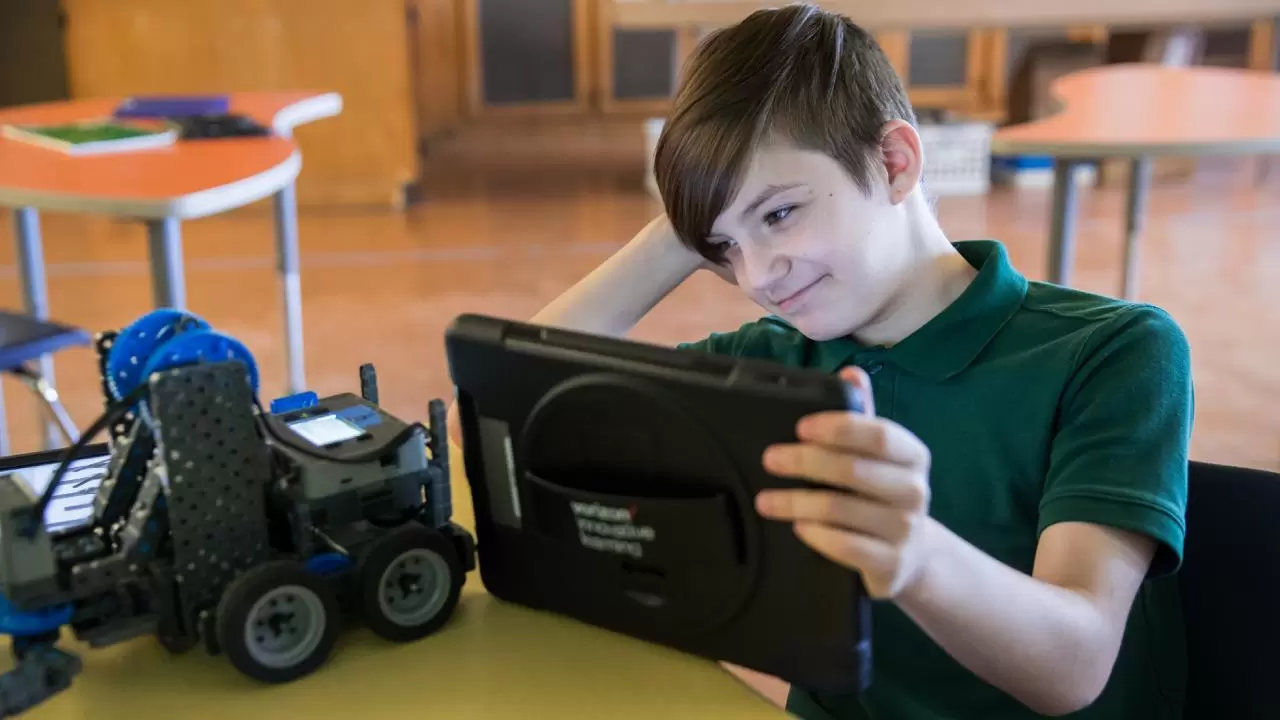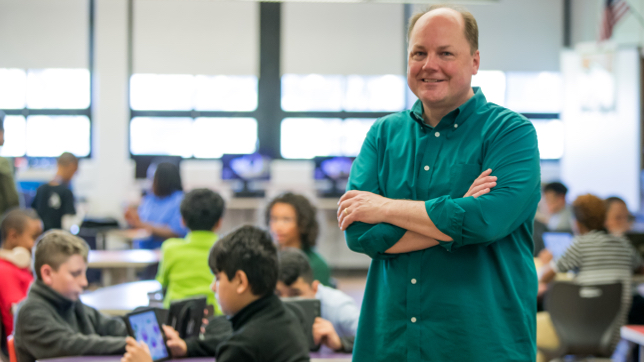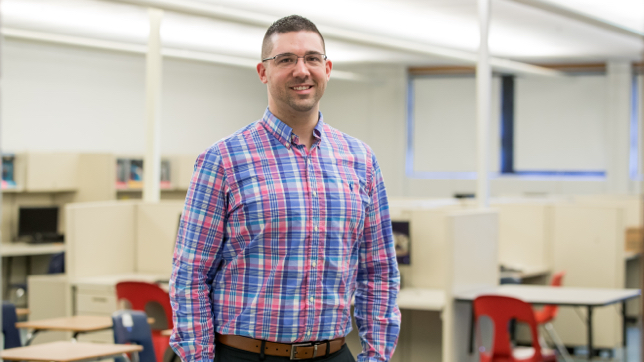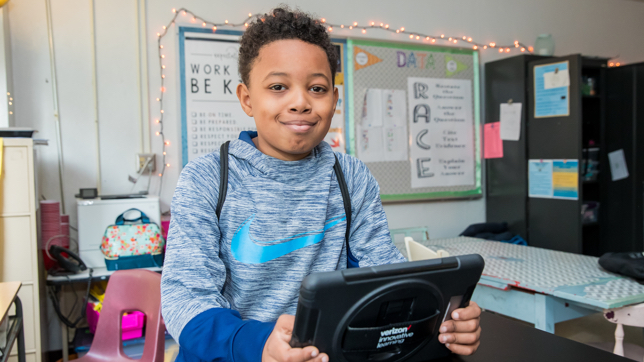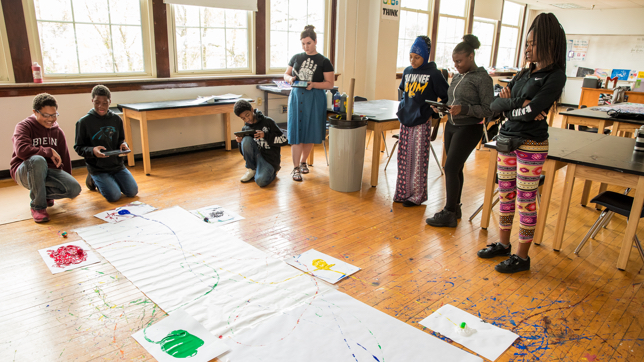Two teachers use tech—in different ways—to transform their classrooms
Verizon recognizes outstanding teachers for improving test scores, creating leaders and inspiring kids to love school.
Verizon celebrates Tom Wolken and Samantha McCarthy, two dedicated teachers, located at two different Verizon Innovative Learning schools in Louisville, Kentucky. Their dynamic—and divergent—approach to technology and learning shapes young minds and creates STEM pathways for their students. At Olmsted Academy North, an all-boy’s middle school located in Louisville, Kentucky, robotics teacher Tom Wolken’s enthusiasm for exploring various tech applications is infectious.
Accorious “Corey” Roberts, 6th grade. (Photos: Michael J. LeBrecht II)
Accorious “Corey” Roberts leans over a table to watch a Cue robot travel five miles per hour. He uses his device to control the Cue robot’s movements. “This is a good tool for programming,” the sixth-grader says. “When you tell a robot to do something, it does it. They don’t have common sense.” Corey shares that if he doesn’t plot the robot’s path and code accordingly, the mechanism would simply roll off the table and crash on the floor.
Corey learned to code in Wolken’s robotics class. He is one of nearly 200 students whose imagination has been piqued—and math and problem-solving skills enhanced—by Wolken’s inventive, open approach to learning. This year, Olmsted North received a Verizon Innovative Learning grant, which provides each student with a tablet, data plan and a whole new world of educational possibilities.
Corey is a perfect example of a student who has been transformed by technology. He used to be very shy. “I had low self-esteem,” he says, “because I had been bullied at my last school.
This is part of the Verizon Innovative Learning mission to provide free technology, free Internet access and a next-gen, technology-infused curriculum that changes the way teachers teach and students learn.
Tom Wolken, robotics teacher at Olmsted North
On any given day of the week, Tom Wolken’s students might be immersed in robotics, virtual reality (VR) and augmented reality (AR) projects, SCRATCH, a programming language for kids, 3-D printing and more. Wolken, a former computer programmer, has a passion for robotics and often shares his personal materials with the class. Ultimately, he says, “My goal is building capacity in students. I can’t teach them to be creative, but I can teach them how to use tools [to help them] express their creativity.”
Tom Wolken, robotics teacher at Olmsted North. (Photos: Michael J. LeBrecht II)
Although Wolken has been teaching for more than a decade, this is his first year teaching robotics. Students in Wolken’s classroom see his passion for STEM projects. When one of his students asks about the 3-D printer, his eyes light up and he says, “Can I borrow someone’s shoes?” Promptly, an eighth-grader slips off his sneaker and hands it to Wolken, who places it on a Lazy Susan that Wolken fashioned from a square piece of wood and ball bearings from Home Depot. As a student slowly turns the Lazy Susan, Wolken holds up a device and scans the shoe, creating a 3-D file. They’ll shrink it down a bit before sending it to the 3-D printer. “This is an opportunity to talk about scaling, so it’s related to math,” Wolken says.
Each day, Wolken lists as many as eight programs on the white board and allows his students to choose an activity. Once students make a selection, the talking quiets down as they split into small groups to tackle the current task. Wolken praises the technology for giving him more freedom to do one-on-one work in the classroom: “The device has made learning more individualized.”
Technology has provided more interactive opportunities, transforming how students create and explore projects. For example, Wolken purchased a MERGE cube, a small 3-D product that acts as an AR screen, and invited students to build larger cubes. When they use CoSpace, an educational technology that enables students and teachers use to design an AR world (like, say, one inhabited by dragons), they can set their handmade MERGE cube in the center of a table. Then, using their device to project the AR onto the cube, bring the scene comes to “life” in a way that wouldn’t be possible with desktop learning.
Life before Verizon Innovative Learning feels like a distant memory.
William Pierce, Verizon Innovative Learning coach. (Photos: Michael J. LeBrecht II)
William Pierce, Verizon Innovative Learning coach
William Pierce, the school’s Verizon Innovative Learning coach, notes that in the past, the school’s tech curriculum focused on teaching students how to use Microsoft Office Suite products to pass a district-wide test on 21st century skills. Now, Pierce says, the students are thriving. The devices have heightened their sense of community, with students turning to one another for assistance.
Statewide test scores are beginning to improve.
The new, enhanced exposure to technology has sparked interest in STEM jobs. Pierce says these young scholars, many of whom are from lower economic backgrounds and previously saw playing professional sports in their future, are now actively discussing engineering as career options.
Whatever a student’s challenge—such as a learning disability or an English language learner—Pierce says, “Thanks to technology, you don’t recognize limitations because they are fully engaged and participating in class.”
Corey is a perfect example of a student who has been transformed by technology. He used to be very shy. “I had low self-esteem,” he says, “because I had been bullied at my last school.” Despite limited exposure to technology at home, Corey took to robotics immediately. Wolken, recognizing Corey’s aptitude, asked him to become a teacher’s assistant.
Wolken taught Corey how to guide his fellow students without giving away the answers or doing the work for them. Now, all traces of Corey’s self-consciousness are gone. He says, “Mr. Wolken is a big inspiration. I see all the stuff he does and think, ‘I can do that, too.’”
For Wolken, seeing students blossom is gratifying: “It’s mind-blowing. I’m very happy to be here.”
Across town at The Academy at Shawnee, another tech-savvy middle school, Samantha McCarthy relies on two math-focused apps to inspire students to become tech confident, boost their test scores and be self-motivated for success.
Samantha McCarthy, math teacher at The Academy at Shawnee. (Photos: Michael J. LeBrecht II)
Samantha McCarthy, math teacher at The Academy at Shawnee
Ten miles away from Tom Wolken’s Olmsted Academy North classroom is The Academy of Shawnee. There, math teacher Samantha McCarthy integrates technology into her lessons with a vastly different, but equally transformative approach. In order to teach basic math skills, McCarthy uses technology as a means of offering students consistency, structure and relative simplicity. “If I had to offer another teacher advice on how to incorporate technology into the classroom, I’d say start by picking one app and getting comfortable with it,” she says. “Above all, let the content dictate which app you use, and not the other way around.”
In addition to virtual classroom software, McCarthy employs two math-based apps on a regular basis. The first is ST Math, which offers a class path, where the content directly correlates to what they’re working, and a personal path, where students go at their own pace. The second is Khan Academy, which automatically inputs students’ MAP scores, a standardized test taken three times per year.
With ST Math, the app logs how many minutes students spend working on problems at home, which is key information that McCarthy can track and is a huge benefit when students work in groups. Even when McCarthy works one-on-one with a student, she knows the other students are engaged. Jacobe’s classmate, Ved Lekkla, thrives on independent study and is quick to point out that he spends 100 minutes per night on ST Math. Meanwhile, with Khan Academy, Lekkla can stay on top of his grades.
Prior to this year, McCarthy hadn’t used technology in any formal way.
When she was an elementary school math teacher in Chicago, her students had access to devices, but they lacked institutional support and training, so the tablets doubled as “glorified babysitters.” McCarthy says she was slightly apprehensive, before the school year began, about utilizing tablets. But after being exposed to the new possibilities, she made a vow to herself: “This time I’m going to do better.”
McCarthy credits Verizon Innovative Learning, including the steadfast backing of Sara Meireding, Shawnee’s Verizon Innovative Learning coach. “With everything, Verizon and Sara did, it was simple,” McCarthy says, noting the seamless adoption of tech.
“My math score increased 15 points from the fall,” Jacobe says proudly.
When asked about the apps, sixth-grader Jacobe Farris rapidly fires off the benefits of each app and how he uses them at home. McCarthy laughs when she hears this: “They’re probably sick of hearing me say it. If the technology is going to be useful, repetition is key.”
Shawnee students work on their Jackson-Pollack inspired painting. (Photos: Michael J. LeBrecht II)
At Shawnee, Meireding organizes weekly professional development check-ins and encourages teachers to collaborate and share innovative technology use. For example, during a mini-lesson on artist Jackson Pollock, another teacher, Maggi Reed, lead a lesson on programming robots to make colorful splatter paintings, à la Pollock. Overall, Meireding is impressed by McCarthy’s ability to make these tech resources work for her teaching style. “She is organized and clear, and so the way she structures her classroom keeps students organized, too,” Meireding says, pointing out that McCarthy’s students adore her.
Aside from teaching fractions, division and decimals, McCarthy’s goal is to help the students find their intrinsic motivation, a quality that will serve them in all areas of life, especially since some have experienced serious trauma and others lack parental support. No matter the student’s individual situation, McCarthy cares about them and her no-nonsense, individualized approach is designed to keep students on task. “When you have high expectations for yourself and someone who respects you has high expectations for you, you tend to rise to the occasion,” she says. “Even if it’s only three out of five days you’re rising to the occasion and the other two you crumble, that’s progress.”
With devices, there’s zero chance the dog will eat anyone’s homework.
Plus, students are more comfortable and engaged with app-based learning. When McCarthy was a substitute teacher one particular student was famous for falling asleep in every class. These days, he’s more alert and recently, he eagerly participated in a lesson on ratios. “He shocked me,” she says. “I thought, ‘Where did you come from?’”
Sabrina Bakare, 7th grade. (Photos: Michael J. LeBrecht II)
Seventh-grader Sabrina Bakare is also aware of her growth. “At first, I was like, ‘Why do we need [devices]?’” she says, recalling her initial resistance. “Now? I know I’m a better student. [The device] helps me a lot. I do better on tests and I like the challenge of learning math.”
Learn how Verizon Innovative Learning is helping kids have a brighter future by providing under-resourced students with free technology, free access and hands-on learning experiences at verizoninnovativelearning.com.
For related media inquiries, please contact story.inquiry@one.verizon.com
Photo credit: Michael J. LeBrecht II
